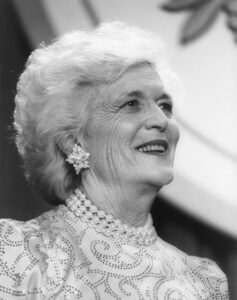
Goodbye Mrs. Bush
Barbara Bush, the former First Lady and the father of President George W. Bush, died last Tuesday at the couple’s home in Houston, Texas. She was 92 years old. Her death was caused by lung disease and congestive heart failure. Despite her failing health, she had decided not to seek further treatment and instead focused on making the end of her life as comfortable as possible.

Credit: Library of Congress, Prints & Photographs Division [LC-USZ62-98303]
The funeral was attended by many dignitaries, such as Bill and Hillary Clinton, and Barack and Michelle Obama. President Trump did not attend, because of the additional security that is necessary whenever a sitting president attends an event, but First Lady Melania Trump went. The Bushes and Trumps have a historically poor relationship. Trump often attacked Barbara’s son Jeb Bush when the two were running against each other for the Republican presidential nomination in 2016, and Mrs. Bush was very outspoken in her criticism of Trump’s treatment of women.
Thousands of people came to pay their respects to the former First Lady where she lay in repose at St. Martin’s Episcopal Church in Houston, many of them wearing pearls as a nod to Mrs. Bush’s most famous fashion accessory.
Dig Deeper Using internet resources, create a timeline of the key events in Barbara Bush’s life. Be sure to include her time as Second Lady (wife of the vice president) and First Lady, as well as important events in her personal life.
National School Walkout Day
Last Friday, April 20, students all over the country walked out of their classrooms at 10:00 am to honor the 13 victims of the Columbine High School shooting 19 years ago, and to protest for gun reform.
More than 2,600 walkouts were planned for April 20. Student protestors were encouraged to wear orange (the color of the anti-gun movement) and to honor the 13 victims of the Columbine shooting with 13 seconds of silence. Unlike the March 14 walkout — when students left their classrooms for 17 minutes and then returned — this was an all-day walkout, meaning students didn’t return to their classrooms for the rest of the day. In addition to moments of silence, many of the protests featured speakers. Others sought different forms of remembrance, such as setting out 13 empty chairs; chanting and singing; or using the time to register people to vote.
The idea for the walkout originally came from Lane Murdock, a 16-year-old student at Ridgefield High School in Connecticut, who began by circulating an online petition after the February school shooting in Parkland, Florida. Her goal was to combat what she felt was a growing feeling of numbness in the US about mass shootings, and to empower other teenagers who might feel powerless to change things.
Ironically, right before the walkouts were set to start, a student at Forest High School in Ocala, Florida, was shot in the ankle by a 19-year-old suspect. The student was taken to the hospital and is not suffering from life-threatening injuries, though police said the shooting was intentional.
What Do You Think? Did you participate in National Walkout Day? Why or why not? If you did, describe your experiences. (And as always, please remember to be respectful and sensitive with your response.)
Prison Riot Turns Deadly
On April 15, a deadly riot raged at Lee Correctional Institute, a maximum-security prison in South Carolina. It began as a fight between gangs and ended with 7 inmates killed and 17 more injured, most of them from slash and stab wounds.
To complicate matters, after the riot broke out, it took more than four hours for prison guards to arrive on the scene. Critics say that if the guards entered earlier, they could have prevented many of the prisoner deaths and injuries resulting from the fight. But according to the director of the prison, the delay couldn’t be helped. When the riot began at 7:15pm, there were only a few guards on the scene, and they were armed only with pepper spray. Knowing that they would be dangerously outnumbered, they waited to go in until a large armed SWAT team could be assembled. But in a rural area on a Sunday night, that took until about 11:30pm. Meanwhile, inside the prison, the bodies began to pile up.
Lee Correctional Institute is widely considered the most dangerous prison in South Carolina. Authorities say there are too few guards to adequately handle the 1,500 male inmates. In 2015, two officers were stabbed during a fight. Since then, three more inmates have been killed: one last July, one last November, and one this past February. But last Sunday’s riot was the deadliest in the last quarter-century.
Dig Deeper Use internet resources to find out about the deadliest prison riot in American history. Where did it take place? How many people were killed or injured? In your opinion, what can be done to prevent deadly prison riots like this from happening again in the future?
Teachers, Banks, and Guns
The American Federation of Teachers (AFT), a national teachers’ union with 1.7 million members, is putting its money where its mouth is. Last week, union officials announced that they are ending their relationship with the banking company Wells Fargo, because of the bank’s refusal to take a stand against the gun violence that affects teachers and students every day.
Up until now, Wells Fargo has been a recommended mortgage lender for the AFT. The bank currently handles more than 20,000 mortgages for AFT members. But after the shooting at Marjory Stoneman Douglas High School in Parkland, Florida, on February 14, AFT leaders tried to reach out to Wells Fargo to see what steps the company was taking to mitigate gun violence. According to the union, the bank never responded to their requests to meet. Therefore, the union decided to end its relationship with the company.
According to union leadership, the union has a responsibility to protect its students and teachers, and to stand up for their best interests. They point out that other banks – such as Chase, Bank of America, Citigroup, and more – have already cut ties with the NRA and other members of the gun industry. But Wells Fargo refuses to do that. So the union refuses to continue supporting Wells Fargo.
But according to the bank’s CEO, Tim Sloan, the gun debate is best settled through the legislative process, not by individual companies. He says that gun regulation is up to lawmakers and that companies shouldn’t be deciding which legal products Americans can and can’t buy.
